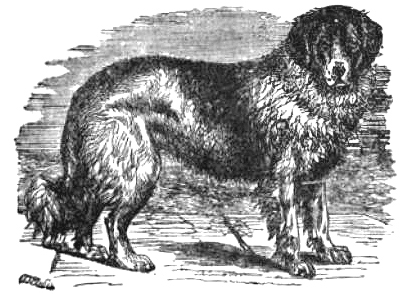[ The Encyclopædia Britannica: A Dictionary of Arts, Sciences, and General Literature ]
The following entry is from the 9th edition, Volume 7 (New York: Henry Allen, 1890), and includes the accompanying illustration. (The 1888 edition of this encyclopedia has exactly the same entry.)
The Newfoundland and Great St Bernard or Alpine Dogs occupy an uncertain position, forming, according to some authorities, a group by themselves, and being classed by others among the wolf-like dogs, although in their large and pendulous ears they differ widely from the typical forms already noticed.
The Newfoundland Dog is believed to have been brought to England from the island to which it owes its name, but probably owing to partial crossing, it differs somewhat from the original Anierican breed, the latter being smaller in size, with the muzzle less blunted, and almost totally black in colour. In Newfoundland and Labrador these dogs are used as beasts of burden, drawing considerable loads of wood and provisions on sledges. The feet are partially webbed, and consequently they are unrivalled as water-dogs, and although their weakness of scent and comparative slowness of foot renders them useless to the hunter, yet in a country of fens and morasses, the sportsman finds them of the greatest service in rescuing birds that have fallen into the water; nor do they hesitate in their eagerness for retrieving to make their way through the roughest cover. The English variety of Newfoundland Dog is a noble creature, standing 30 inches high at the shoulders, its hair waved or curly and of a black and white colour in nearly equal proportions, its tail massive and bushy and curled upwards at the extremity. Equally noble in disposition, it does not allow the annoyance of smaller dogs to disturb its serenity, while its patience with children is not readily exhausted. In defence of its master's property it will fly with bull-dog ferocity at any intruder, while it will battle with the waters to save him from drowning. Its services in the saving of life are well known. When kept in confinement its temper is more variable, and in a fit of frustration these dogs have been known to attack those for whom they have previously shown the greatest regard; but even in confinement such cases are altogether exceptional. This breed is supposed by some not to be indigenous to North America, but to have been introduced either on the first discovery of Newfoundland by the Norwegians about the year l000, or on its re-discovery by Cabot in 1497. The Norwegians, according to Martin, have dogs closely resembling the Newfoundland breed, which are used in hunting bears and wolves, and which are armed with spiked collars in order to protect them from the wolves which seek to seize them by the throat. The Great St Bernard Dog of the present day is a powerful animal, as large as a mastiff; with close short hair and pendulous ears, and varying in colour, in one case being described as "sandy red or tawny" with black muzzle, in another as "more or lees marked with grey, liver colour, and black clouds." Previous to 1820 there existed another breed of these dogs, closely allied in form and size to the Newfoundland, but in that year the greater portion of them died of an epidemic, which neceesitated the introduction of the present variety. These dogs are kept by the monks of the Hospice of St Bernard, in their convent, situated on one of the most dangerous passes between Switzerland and Italy, near the top of the Great St Bernard, where they are trained to the work of rescuing travellers who, overtaken by the snowstorm, may have lost their way, or sunk benumbed by the cold. On such occasions these sagacious and poerful dogs set out from the convent in pairs, one bearing a flask of spirits attached to his neck, the other a cloak. Should they come upon the baffled yet struggling traveller, they conduct him to the convent; but should he have succumbed and be covered by the snow, their keen scent detects his presence although buried several feet beneath the surface.


